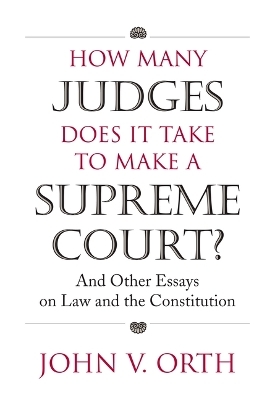
How Many Judges Does it Take to Make a Supreme Court?
And Other Essays on Law and the Constitution
Seiten
2006
University Press of Kansas (Verlag)
978-0-7006-1478-3 (ISBN)
University Press of Kansas (Verlag)
978-0-7006-1478-3 (ISBN)
Invites students of the law to look at the origins of accepted legal practices as a means of gaining insight into the judicial role and the evolution of common law. This work considers how the centuries-old common law tradition interacts with statutory law-making, and why claims that individual rights are grounded in common law are suspect.
Why do appellate courts always have an odd number of judges? And what does the answer tell us about changing concepts of law? How can common law be unconstitutional? Why does the power of judges depend on accurate court reporting? Because legal education today has come to focus so much on teaching students ""how to think like lawyers,"" some subjects do not fit comfortably in law school curricula. John Orth, a distinguished senior law scholar, here explores some of these neglected but important topics. His insightful volume invites students of the law to look at the origins of accepted legal practices as a means of gaining insight into the judicial role and the evolution of common law. In six carefully reasoned and clearly argued articles, Orth presents the familiar in a fresh light. He considers, in addition to the questions already mentioned, how the centuries-old common law tradition interacts with statutory law-making, why claims that individual rights are grounded in common law are suspect, and how the common law uses what it learns about the past. In considering these questions related to common law and its remarkable longevity, Orth illuminates both its interaction with written constitutions and its longstanding preoccupation with procedure and property. And by questioning the assertion that individualism was the cornerstone of common law, he deftly resolves an objection that liberal scholars sometimes raise concerning common law - its connection to the Lochner era of Supreme Court jurisprudence. How many judges does it take to make a supreme court? As Orth observes, the institutional novelty of odd numbers of judges provided a means to break ties but did nothing to guarantee acceptance of their decisions. By demonstrating that what seems obvious about the law today was not always so, he cogently addresses changing perceptions of law and invites its future practitioners not only to think like lawyers but also to be more fully grounded in the law.
Why do appellate courts always have an odd number of judges? And what does the answer tell us about changing concepts of law? How can common law be unconstitutional? Why does the power of judges depend on accurate court reporting? Because legal education today has come to focus so much on teaching students ""how to think like lawyers,"" some subjects do not fit comfortably in law school curricula. John Orth, a distinguished senior law scholar, here explores some of these neglected but important topics. His insightful volume invites students of the law to look at the origins of accepted legal practices as a means of gaining insight into the judicial role and the evolution of common law. In six carefully reasoned and clearly argued articles, Orth presents the familiar in a fresh light. He considers, in addition to the questions already mentioned, how the centuries-old common law tradition interacts with statutory law-making, why claims that individual rights are grounded in common law are suspect, and how the common law uses what it learns about the past. In considering these questions related to common law and its remarkable longevity, Orth illuminates both its interaction with written constitutions and its longstanding preoccupation with procedure and property. And by questioning the assertion that individualism was the cornerstone of common law, he deftly resolves an objection that liberal scholars sometimes raise concerning common law - its connection to the Lochner era of Supreme Court jurisprudence. How many judges does it take to make a supreme court? As Orth observes, the institutional novelty of odd numbers of judges provided a means to break ties but did nothing to guarantee acceptance of their decisions. By demonstrating that what seems obvious about the law today was not always so, he cogently addresses changing perceptions of law and invites its future practitioners not only to think like lawyers but also to be more fully grounded in the law.
John V. Orth is William Rand Kenan, Jr., Professor of Law at the University of North Carolina at Chapel Hill. Other books by Orth include Combination and Conspiracy: A Legal History of Trade Unionism, 1721-1906; The Judicial Power of the United States: The Eleventh Amendment in American History; and Due Process of Law: A Brief History (see page 36).
| Verlagsort | Kansas |
|---|---|
| Sprache | englisch |
| Maße | 146 x 198 mm |
| Gewicht | 300 g |
| Themenwelt | Geschichte ► Teilgebiete der Geschichte ► Militärgeschichte |
| Recht / Steuern ► Allgemeines / Lexika | |
| Recht / Steuern ► EU / Internationales Recht | |
| Recht / Steuern ► Rechtsgeschichte | |
| ISBN-10 | 0-7006-1478-8 / 0700614788 |
| ISBN-13 | 978-0-7006-1478-3 / 9780700614783 |
| Zustand | Neuware |
| Haben Sie eine Frage zum Produkt? |
Mehr entdecken
aus dem Bereich
aus dem Bereich
neueste Manipulationstechniken als Waffengattung der NATO
Buch | Softcover (2023)
Westend (Verlag)
24,00 €
Deutschlands Schwäche in der Zeitenwende
Buch | Softcover (2023)
C.H.Beck (Verlag)
18,00 €


